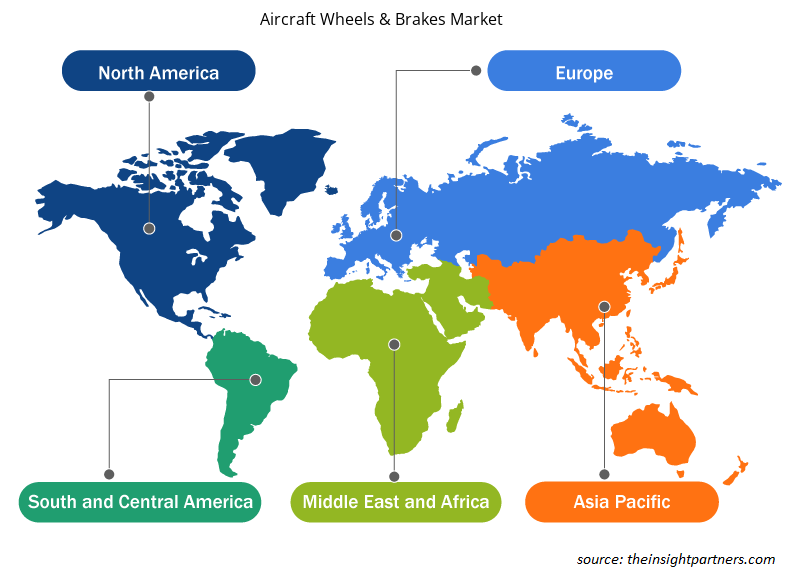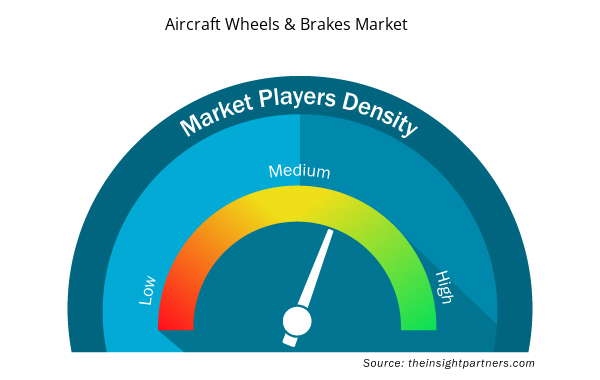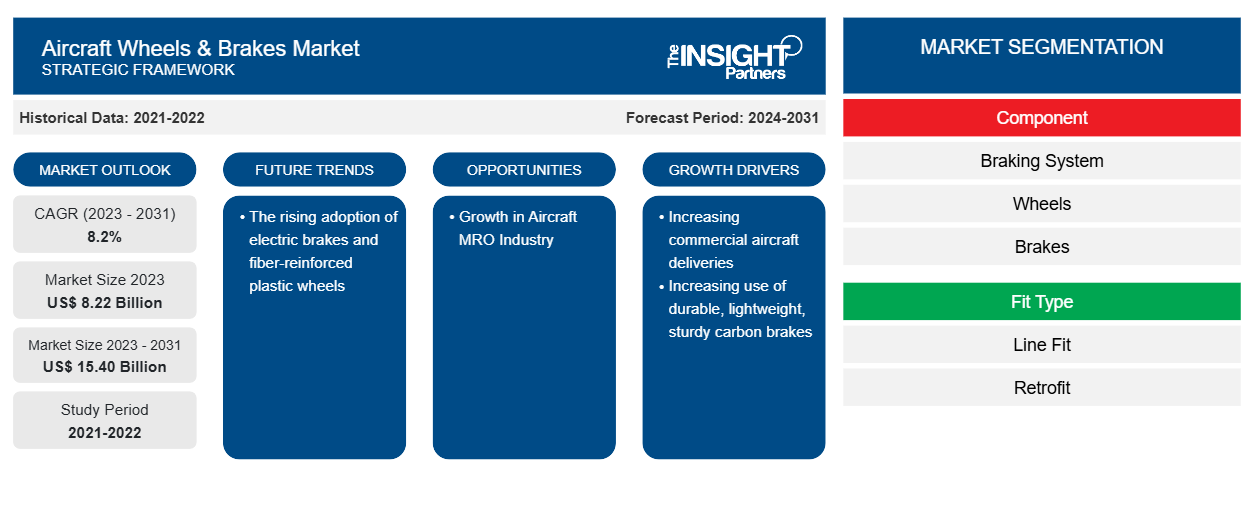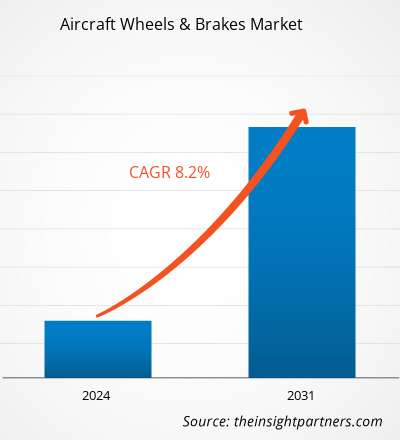航空機用ホイールおよびブレーキの市場規模は、2023年の82億2,000万米ドルから2031年には154億米ドルに達すると予測されています。市場は2023年から2031年の間に8.2%のCAGRを記録すると予想されています。電動ブレーキと繊維強化プラスチックホイールの採用の増加は、引き続き市場の重要なトレンドとなると思われます。
航空機用ホイールとブレーキ市場分析
航空機のホイールとブレーキ市場は、Honeywell International Inc、Parker Hannifin Corporation、Safran Group、Crane Aerospace & Electronicsなどの大手企業が支配しています。航空機メーカーの間では、ホイールとブレーキの需要が大幅に増加しています。ただし、契約のほとんどは大手企業に発注されています。さらに、これらのホイールとブレーキの製造には、監督当局が設定したいくつかの基準に準拠する必要があります。これには、さまざまな認証の取得とR&Dへの多額の投資が含まれ、この分野への新規参入が制限されます。したがって、現在の状況では、新規参入者のビジネスに対する脅威は高いですが、航空機の生産量の増加に伴い、新規プレーヤーの出現が予測されます。これにより、いくつかの小規模または中規模の航空機メーカーが、競争力のある価格で高度な技術のホイールとブレーキを提供する新規参入者からホイールとブレーキを調達するため、新規参入者への脅威は低下すると予想されます。
航空機用ホイールおよびブレーキ市場の概要
航空機の車輪とブレーキ市場のエコシステムは、原材料と部品のプロバイダー、航空機の車輪とブレーキのメーカー、航空機メーカー、エンドユーザーなどの利害関係者で構成されています。航空機の車輪とブレーキのメーカーは、スチール、アルミニウム、マグネシウム合金、カーボンフィクション材料などの原材料と部品を調達し、センサーやアクチュエータなどの部品はさまざまな原材料と部品のプロバイダーから調達しています。航空機の車輪とブレーキのメーカーは、原材料と部品を組み立てて完成品に製造します。航空機の車輪とブレーキのメーカーは、航空当局、原材料サプライヤー、航空機メーカー、エンドユーザーと連携して作業しています。市場で活動している著名なプレーヤーには、コリンズエアロスペース、ハネウェルインターナショナルインク、サフラングループ、パーカーハネフィンコーポレーションなどがあります。さらに、航空機メーカーは上記のプレーヤーから車輪とブレーキを調達し、ラインフィット活動を通じて航空機の艦隊にそれらを取り付けます。最後に、航空会社、さまざまな国の軍隊、MROサービスプロバイダーなどのエンドユーザーは、航空機の車輪とブレーキのMRO活動の契約を獲得します。 MRO サービス プロバイダーは、航空機のホイールとブレーキの MRO に対する需要の高まりに応じて継続的にサービスを提供するために、市場プレーヤーからホイールとブレーキを継続的に調達しています。
要件に合わせてレポートをカスタマイズする
このレポートの一部、国レベルの分析、Excelデータパックなど、あらゆるレポートを無料でカスタマイズできます。また、スタートアップや大学向けのお得なオファーや割引もご利用いただけます。
- このレポートの主要な市場動向を入手してください。この無料サンプルには、市場動向から見積もりや予測に至るまでのデータ分析が含まれます。
航空機用ホイールとブレーキ市場の地域別分析
予測期間を通じて航空機用ホイールおよびブレーキ市場に影響を与える地域的な傾向と要因は、Insight Partners のアナリストによって徹底的に説明されています。このセクションでは、北米、ヨーロッパ、アジア太平洋、中東およびアフリカ、南米および中米にわたる航空機用ホイールおよびブレーキ市場のセグメントと地理についても説明します。

- 航空機用ホイールとブレーキ市場の地域別データを入手
航空機用ホイールとブレーキ市場レポートの範囲
| レポート属性 | 詳細 |
|---|---|
| 2023年の市場規模 | 82億2千万米ドル |
| 2031年までの市場規模 | 154億米ドル |
| 世界のCAGR(2023年~2031年) | 8.2% |
| 履歴データ | 2021-2022 |
| 予測期間 | 2024-2031 |
| 対象セグメント | コンポーネント別
|
| 対象地域と国 | 北米
|
| 市場リーダーと主要企業プロフィール |
|
市場プレーヤーの密度:ビジネスダイナミクスへの影響を理解する
航空機のホイールとブレーキ市場は、消費者の嗜好の変化、技術の進歩、製品の利点に対する認識の高まりなどの要因により、エンドユーザーの需要が高まり、急速に成長しています。需要が高まるにつれて、企業は提供を拡大し、消費者のニーズを満たすために革新し、新たなトレンドを活用し、市場の成長をさらに促進しています。
市場プレーヤー密度とは、特定の市場または業界内で活動している企業または会社の分布を指します。これは、特定の市場スペースに、その市場規模または総市場価値に対してどれだけの競合相手 (市場プレーヤー) が存在するかを示します。
航空機用ホイールおよびブレーキ市場で事業を展開している主要企業は次のとおりです。
- ベリンガーエアロ
- コリンズエアロスペース
- ハネウェルインターナショナル株式会社
- メギットPLC
- パーカー・ハネフィン株式会社
免責事項:上記の企業は、特定の順序でランク付けされていません。

- 航空機用ホイールとブレーキ市場のトップキープレーヤーの概要を入手
航空機用ホイールとブレーキ市場のニュースと最近の動向
航空機の車輪とブレーキ市場は、主要な企業出版物、協会データ、データベースを含む一次調査と二次調査後の定性的および定量的データを収集することによって評価されます。航空機の車輪とブレーキ市場の動向のいくつかを以下に示します。
- サフラン ランディング システムズは、フランスのヴェリジー=ヴィラクブレー工場に、ホイールとカーボン ブレーキのテスト専用の全面改装された研究所を開設しました。この研究所には新しいテスト ベンチが備えられています。この野心的なプロジェクトを実行するために、同社は総額 1,000 万ユーロを投資します。その結果、責任ある労働環境が生まれ、サフランはより高性能で耐久性が高く競争力のあるブレーキを開発および認定する能力を強化し、顧客の生産拡大に対応することが約束されます。これは、民間、軍事、ビジネス航空のほぼすべてのセグメントに適用されます。(出典: サフラン、プレス リリース、2024 年 4 月)
- モーション&コントロール技術の世界的リーダーであるパーカー・ハネフィン・コーポレーション(NYSE:PH、「パーカー」)は本日、米国オハイオ州エイボンにある航空機用ホイールおよびブレーキ部門をカマン・コーポレーション(NYSE:KAMN)に売却するという、以前に発表した取引を完了したことを発表しました。コネチカット州ブルームフィールドに本社を置くカマンは、航空宇宙、防衛、産業、医療市場向けの部品および材料の大手メーカーです。(出典:パーカー・ハネフィン・コーポレーション、プレスリリース、2022年9月)
航空機用ホイールとブレーキ市場レポートのカバー範囲と成果物
「航空機用ホイールおよびブレーキ市場の規模と予測(2021〜2031年)」レポートでは、以下の分野をカバーする市場の詳細な分析を提供しています。
- 航空機用ホイールとブレーキ市場の市場規模と予測、対象範囲に含まれるすべての主要市場セグメントの世界、地域、国レベルでの予測
- 航空機用ホイールとブレーキ市場の市場動向、および推進要因、制約、主要な機会などの市場動向
- ポーターの5つの力の詳細な分析
- 航空機用ホイールとブレーキ市場の市場分析。主要な市場動向、世界および地域の枠組み、主要プレーヤー、規制、最近の市場動向を網羅しています。
- 航空機用ホイールおよびブレーキ市場における市場集中、ヒートマップ分析、主要プレーヤー、最近の動向を網羅した業界展望と競争分析
- 詳細な企業プロフィール
- 過去2年間の分析、基準年、CAGRによる予測(7年間)
- PEST分析とSWOT分析
- 市場規模価値/数量 - 世界、地域、国
- 業界と競争環境
- Excel データセット


- Vision Guided Robotics Software Market
- Cling Films Market
- Authentication and Brand Protection Market
- Sandwich Panel Market
- Fertilizer Additives Market
- Aerospace Forging Market
- Emergency Department Information System (EDIS) Market
- Point of Care Diagnostics Market
- Cell Line Development Market
- Pharmacovigilance and Drug Safety Software Market

Report Coverage
Revenue forecast, Company Analysis, Industry landscape, Growth factors, and Trends

Segment Covered
This text is related
to segments covered.

Regional Scope
North America, Europe, Asia Pacific, Middle East & Africa, South & Central America

Country Scope
This text is related
to country scope.
よくある質問
The aircraft wheels & brakes market is likely to register of 8.2% during 2023-2031.
The estimated value of the aircraft wheels & brakes market by 2031 would be around US$ 15.40 billion.
The rising adoption of electric brakes and fiber-reinforced plastic wheels is one of the major trends of the market.
Honeywell International Inc, Parker Hannifin Corporation, Safran, Collins Aerospace, Beringer Aero, Crane Aerospace and Electronics, Grove Aircraft Landing Gear Systems Inc, Jay-Em Aerospace and Machine Inc, Matco Manufacturing Inc, and TransDigm Group Incorporated are some of the key players profiled under the report.
Increasing commercial aircraft deliveries and increasing use of durable, lightweight, sturdy carbon brakes are some of the factors driving the growth for aircraft wheels & brakes market.
Asia Pacific region dominated the aircraft wheels & brakes market in 2023.
Trends and growth analysis reports related to Aerospace and Defense : READ MORE..
The Insight Partners performs research in 4 major stages: Data Collection & Secondary Research, Primary Research, Data Analysis and Data Triangulation & Final Review.
- Data Collection and Secondary Research:
As a market research and consulting firm operating from a decade, we have published and advised several client across the globe. First step for any study will start with an assessment of currently available data and insights from existing reports. Further, historical and current market information is collected from Investor Presentations, Annual Reports, SEC Filings, etc., and other information related to company’s performance and market positioning are gathered from Paid Databases (Factiva, Hoovers, and Reuters) and various other publications available in public domain.
Several associations trade associates, technical forums, institutes, societies and organization are accessed to gain technical as well as market related insights through their publications such as research papers, blogs and press releases related to the studies are referred to get cues about the market. Further, white papers, journals, magazines, and other news articles published in last 3 years are scrutinized and analyzed to understand the current market trends.
- Primary Research:
The primarily interview analysis comprise of data obtained from industry participants interview and answers to survey questions gathered by in-house primary team.
For primary research, interviews are conducted with industry experts/CEOs/Marketing Managers/VPs/Subject Matter Experts from both demand and supply side to get a 360-degree view of the market. The primary team conducts several interviews based on the complexity of the markets to understand the various market trends and dynamics which makes research more credible and precise.
A typical research interview fulfils the following functions:
- Provides first-hand information on the market size, market trends, growth trends, competitive landscape, and outlook
- Validates and strengthens in-house secondary research findings
- Develops the analysis team’s expertise and market understanding
Primary research involves email interactions and telephone interviews for each market, category, segment, and sub-segment across geographies. The participants who typically take part in such a process include, but are not limited to:
- Industry participants: VPs, business development managers, market intelligence managers and national sales managers
- Outside experts: Valuation experts, research analysts and key opinion leaders specializing in the electronics and semiconductor industry.
Below is the breakup of our primary respondents by company, designation, and region:

Once we receive the confirmation from primary research sources or primary respondents, we finalize the base year market estimation and forecast the data as per the macroeconomic and microeconomic factors assessed during data collection.
- Data Analysis:
Once data is validated through both secondary as well as primary respondents, we finalize the market estimations by hypothesis formulation and factor analysis at regional and country level.
- Macro-Economic Factor Analysis:
We analyse macroeconomic indicators such the gross domestic product (GDP), increase in the demand for goods and services across industries, technological advancement, regional economic growth, governmental policies, the influence of COVID-19, PEST analysis, and other aspects. This analysis aids in setting benchmarks for various nations/regions and approximating market splits. Additionally, the general trend of the aforementioned components aid in determining the market's development possibilities.
- Country Level Data:
Various factors that are especially aligned to the country are taken into account to determine the market size for a certain area and country, including the presence of vendors, such as headquarters and offices, the country's GDP, demand patterns, and industry growth. To comprehend the market dynamics for the nation, a number of growth variables, inhibitors, application areas, and current market trends are researched. The aforementioned elements aid in determining the country's overall market's growth potential.
- Company Profile:
The “Table of Contents” is formulated by listing and analyzing more than 25 - 30 companies operating in the market ecosystem across geographies. However, we profile only 10 companies as a standard practice in our syndicate reports. These 10 companies comprise leading, emerging, and regional players. Nonetheless, our analysis is not restricted to the 10 listed companies, we also analyze other companies present in the market to develop a holistic view and understand the prevailing trends. The “Company Profiles” section in the report covers key facts, business description, products & services, financial information, SWOT analysis, and key developments. The financial information presented is extracted from the annual reports and official documents of the publicly listed companies. Upon collecting the information for the sections of respective companies, we verify them via various primary sources and then compile the data in respective company profiles. The company level information helps us in deriving the base number as well as in forecasting the market size.
- Developing Base Number:
Aggregation of sales statistics (2020-2022) and macro-economic factor, and other secondary and primary research insights are utilized to arrive at base number and related market shares for 2022. The data gaps are identified in this step and relevant market data is analyzed, collected from paid primary interviews or databases. On finalizing the base year market size, forecasts are developed on the basis of macro-economic, industry and market growth factors and company level analysis.
- Data Triangulation and Final Review:
The market findings and base year market size calculations are validated from supply as well as demand side. Demand side validations are based on macro-economic factor analysis and benchmarks for respective regions and countries. In case of supply side validations, revenues of major companies are estimated (in case not available) based on industry benchmark, approximate number of employees, product portfolio, and primary interviews revenues are gathered. Further revenue from target product/service segment is assessed to avoid overshooting of market statistics. In case of heavy deviations between supply and demand side values, all thes steps are repeated to achieve synchronization.
We follow an iterative model, wherein we share our research findings with Subject Matter Experts (SME’s) and Key Opinion Leaders (KOLs) until consensus view of the market is not formulated – this model negates any drastic deviation in the opinions of experts. Only validated and universally acceptable research findings are quoted in our reports.
We have important check points that we use to validate our research findings – which we call – data triangulation, where we validate the information, we generate from secondary sources with primary interviews and then we re-validate with our internal data bases and Subject matter experts. This comprehensive model enables us to deliver high quality, reliable data in shortest possible time.


 このレポートの無料サンプルを入手する
このレポートの無料サンプルを入手する